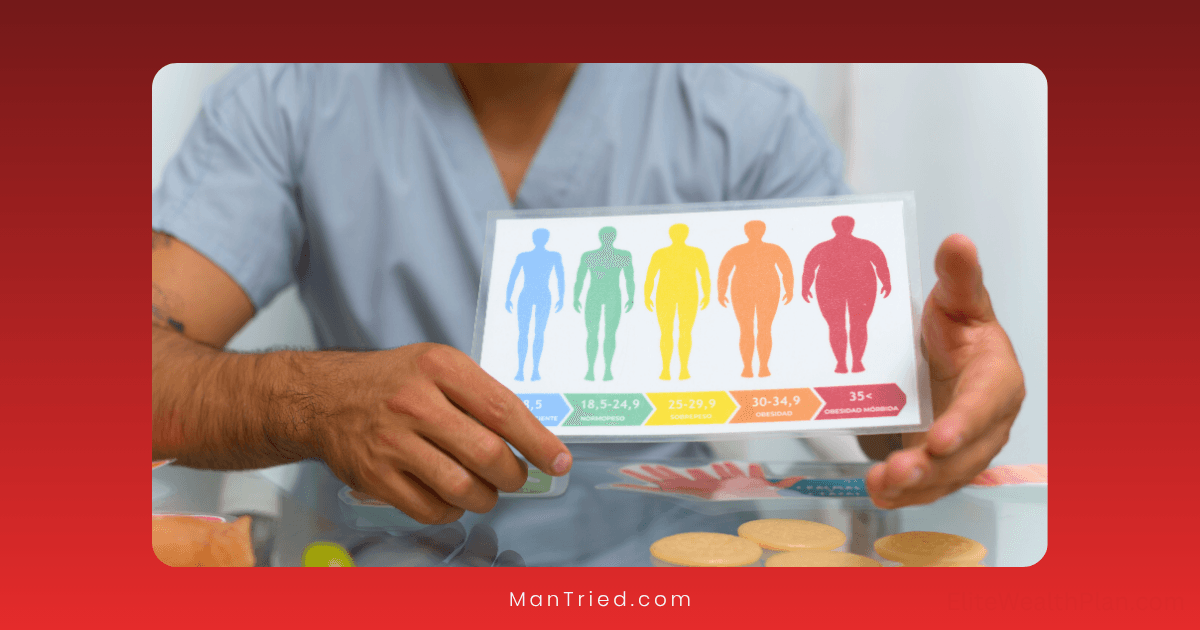Beyond BMI: Body Composition Metrics That Actually Matter for Sexual Health

For decades, Body Mass Index (BMI) has reigned supreme as the go-to measurement for assessing health risks. However, when it comes to sexual health and function, this simple height-to-weight ratio falls woefully short. The truth is, your body’s composition—how your weight is distributed between muscle, fat, and where that fat is stored—tells a much more complete story about your sexual wellbeing.
Recent research reveals that specific body composition metrics can predict sexual function far more accurately than BMI alone. Let’s explore the measurements that truly matter and understand how they influence your hormones, blood flow, and ultimately, your sexual health.
Why BMI Falls Short
BMI was never designed to assess individual health. Belgian mathematician Adolphe Quetelet developed it in the 1830s as a population-level statistical tool. Today, its limitations are well-documented:
- It doesn’t distinguish between muscle and fat
- It ignores where fat is distributed on your body
- It fails to account for age, sex, or ethnicity
- It can’t detect metabolic health issues in “normal weight” individuals
As research published in Nature demonstrates, BMI alone misses crucial factors that directly impact sexual function. So what metrics should we be tracking instead?
The Body Composition Metrics That Actually Predict Sexual Health
1. Waist-to-Hip Ratio (WHR)
Perhaps the most accessible and telling measurement is your waist-to-hip ratio—the circumference of your waist divided by the circumference of your hips.
Why it matters for sexual health:
- For men: A WHR above 0.95 correlates with lower testosterone levels and increased risk of erectile dysfunction (ED). A study of 514 participants found significant associations between higher WHR and reduced sexual function.
- For women: WHR above 0.85 is linked to hormonal imbalances affecting arousal and satisfaction. The same study found WHR was significantly related to sexual arousal (P = 0.04) and satisfaction (P = 0.02).
- For all genders: Higher WHR indicates central obesity, which restricts blood flow to genital tissues and increases inflammation—both critical factors in sexual arousal and function.
How to measure it: Using a flexible tape measure, measure your waist at the narrowest point (usually at the navel) and your hips at their widest point. Divide the waist measurement by the hip measurement.
2. Visceral Fat Levels
Unlike subcutaneous fat that you can pinch under your skin, visceral fat wraps around your internal organs. It’s metabolically active, producing hormones and inflammatory substances that directly impact sexual function.
Why it matters for sexual health:
- Visceral fat increases estrogen production in men while decreasing testosterone
- It promotes insulin resistance, which damages blood vessels essential for arousal
- It triggers chronic inflammation that impairs nitric oxide production—crucial for erectile function
- Higher visceral fat is linked to increased risk of sexual dysfunction regardless of overall weight
According to Dr. Emin Özbek, a urologist specializing in sexual medicine, “Visceral fat, located around vital organs, poses a greater health risk than subcutaneous fat and is strongly associated with erectile dysfunction through multiple pathways including hormonal imbalances and vascular damage.”.
How to measure it: While the gold standard requires imaging (CT or MRI scans), you can use specialized scales with bioelectrical impedance analysis (BIA) technology or track your waist circumference as a proxy (over 40 inches for men or 35 inches for women indicates excess visceral fat).
3. Skeletal Muscle Mass-to-Visceral Fat Ratio (SVR)
This emerging metric provides valuable insights into metabolic health and hormonal balance by comparing muscle mass to visceral fat.
Why it matters for sexual health:
- Higher muscle mass supports healthy testosterone levels in all sexes
- Muscle tissue improves insulin sensitivity, protecting vascular function
- A higher SVR indicates a more favorable hormonal environment for sexual function
- Research shows a positive correlation between SVR and overall metabolic health
A study published in the National Library of Medicine found significant differences in SVR between sexes, with men exhibiting a strong positive association between SVR and overall health markers.
How to measure it: This typically requires professional body composition analysis through DEXA scans or advanced BIA devices available at some fitness centers and medical facilities.
4. Metabolic Age
Your metabolic age compares your Basal Metabolic Rate (BMR) to the average BMR of people your chronological age.
Why it matters for sexual health:
A study of men under 40 found that those with erectile dysfunction had a significantly higher metabolic age (44.63 ± 6.9 years) compared to those without ED (39.9 ± 8.59 years). This suggests that your body’s metabolic function—not just your chronological age—plays a crucial role in sexual health.
How to measure it: Many advanced body composition scales can calculate this, or you can have it measured at specialized health clinics.
5. Novel Anthropometric Indices
Recent research has developed several new metrics that combine multiple measurements to better predict health outcomes, including sexual function:
- Lipid Accumulation Product (LAP): Combines waist circumference and triglyceride levels
- Triglyceride Glucose Index (TyG): Assesses insulin resistance
- Waist Triglyceride Index (WTI): Combines waist circumference with triglyceride levels
- Weight-Adjusted Waist Index (WWI): Adjusts waist circumference based on weight
- A Body Shape Index (ABSI): Incorporates height, weight, and waist circumference
A 2024 study in Nature Scientific Reports found that for each one-unit increase in ABSI, the odds of erectile dysfunction increased by 62.11%—a much stronger predictor than BMI alone.
The Hormonal Connection: How Body Composition Affects Sexual Health
Your body composition directly influences the hormones that drive sexual function:
Testosterone
- In men: Higher visceral fat and lower muscle mass are associated with lower testosterone levels. A comprehensive study found that testosterone is positively correlated with lean mass and inversely correlated with fat mass.
- In women: Testosterone contributes to sexual desire and arousal. While the relationship is complex, excessive visceral fat can disrupt optimal testosterone levels in women as well.
Estrogen
- In men: Excess body fat increases estrogen levels through aromatization (the conversion of testosterone to estrogen), which can further reduce testosterone and impair sexual function.
- In women: Body fat distribution affects estrogen levels and activity. According to research in the National Library of Medicine, estradiol levels in women are positively associated with lean mass and negatively associated with fat mass.
Sex Hormone Binding Globulin (SHBG)
- Higher levels of visceral fat decrease SHBG, which normally binds excess hormones in the bloodstream
- Lower SHBG means more estrogen activity in men (negative for sexual function) and potentially disrupted hormone balance in women
Beyond Hormones: Other Mechanisms Linking Body Composition to Sexual Function
Body composition affects sexual health through multiple pathways:
1. Vascular Health
Sexual arousal depends on healthy blood flow to genital tissues. Excess visceral fat:
- Promotes endothelial dysfunction, impairing blood vessel dilation
- Increases inflammation, damaging small blood vessels
- Contributes to atherosclerosis, restricting blood flow
2. Neurological Function
Sexual arousal and orgasm rely on complex neurological pathways that can be impaired by:
- Insulin resistance associated with poor body composition
- Inflammatory cytokines produced by visceral fat
- Oxidative stress that damages nerve tissue
3. Psychological Factors
While physical mechanisms are important, psychological aspects of body composition also matter:
- Body image concerns can trigger anxiety during intimate moments
- Self-confidence affects willingness to initiate or engage in sexual activity
- Depression associated with certain body composition patterns can reduce libido
Practical Steps to Improve Body Composition for Better Sexual Health
If your body composition metrics suggest room for improvement, consider these evidence-based approaches:
1. Prioritize Resistance Training
Muscle tissue is metabolically active and supports hormone balance:
- Aim for at least 2-3 strength training sessions weekly
- Focus on compound movements that engage multiple muscle groups
- Progressive overload (gradually increasing weight) optimizes results
2. Target Visceral Fat Specifically
Not all exercise equally affects visceral fat:
- High-intensity interval training (HIIT) shows superior results for reducing visceral fat
- Regular moderate-intensity cardio (30+ minutes, 3-5 times weekly)
- Stress management (cortisol promotes visceral fat storage)
3. Adopt an Anti-Inflammatory Diet
What you eat directly impacts body composition and sexual health:
- Emphasize omega-3 rich foods (fatty fish, walnuts, flaxseeds)
- Include antioxidant-rich fruits and vegetables
- Limit refined carbohydrates and processed foods
- Moderate alcohol consumption
4. Optimize Sleep
Poor sleep disrupts hormones that regulate body composition:
- Aim for 7-9 hours of quality sleep nightly
- Maintain consistent sleep/wake times
- Create a sleep-friendly environment (dark, cool, quiet)
5. Consider Targeted Supplements
Some supplements may support healthy body composition:
- Vitamin D (if deficient)
- Magnesium
- Omega-3 fatty acids
- Zinc (particularly important for testosterone production)
Success Stories: Real Transformations Beyond the Scale
Michael, 47: “After years of struggling with ED, I learned my visceral fat level was 14 (healthy range is under 10). Through HIIT training and diet changes, I reduced it to 8 over six months. My testosterone increased naturally, and my erectile function improved dramatically—all without significant weight loss. My BMI only changed by 1 point, but my sexual health transformed completely.”
Sophia, 38: “I was always considered ‘skinny fat’—normal BMI but low muscle mass. After adding strength training and improving my SVR, my energy and libido increased significantly. My weight barely changed, but my body composition shifted dramatically, and so did my interest in sex.”
James, 52: “Reducing my waist-to-hip ratio from 1.02 to 0.94 coincided with a complete resolution of my ED issues. My doctor was amazed at how the changes in my body composition improved my vascular health markers. I wish I’d known years ago that it wasn’t about losing weight but changing where I carried it.”
The Bottom Line
When it comes to sexual health, what matters isn’t simply how much you weigh, but how your body composition is structured. By focusing on metrics like waist-to-hip ratio, visceral fat levels, and muscle mass rather than just BMI, you gain a much clearer picture of your metabolic health and potential sexual function.
Remember that improvements in these metrics often yield benefits long before significant weight changes occur. Many people experience enhanced sexual function with relatively modest improvements in body composition—particularly when visceral fat decreases and muscle mass increases.
If you’re concerned about sexual health issues, consider asking your healthcare provider about these more sophisticated measurements. They provide a more complete picture of your health and can guide more effective interventions than focusing on weight alone.
Have you noticed changes in your sexual health after improving your body composition? Share your experiences in the comments below.






